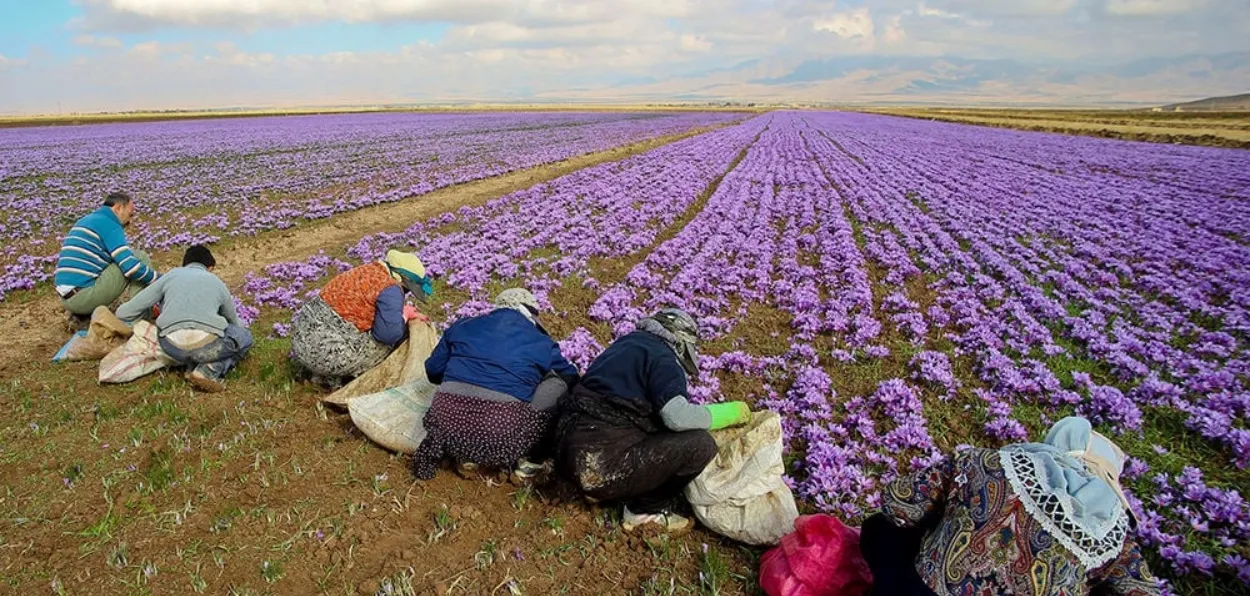
Ehsan Fazili/Pampore
After two bumper crops, saffron blossom in Kashmir was delayed and farmers are expecting a much lower yield due to the ongoing dry spell. The saffron fields of Pampore, close to Srinagar, however, have turned into a purple carpet, and the air is filled with the aroma of the world’s costliest spice.
Saffron farmer Ghulam Mohammad Dar from Konibal village, says he is not happy with the produce this year. Awaz-the Voice met him while he and his wife were picking flowers early morning.
“A long dry spell and non-availability of irrigation facilities has led to the decline in the production”, he said claiming that the irrigation facilities launched by the Government are non-functional.
Plucking saffron flowers is an early morning task and it’s over by noon. Each flower is plucked within two or three days of its blossoming. The harvest is completed within two to three weeks leaving the bulbs under the soil and changing these after four years.
A farmer plucking flowers from his saffron field
Pampore saffron production is looked after by The Department of Agriculture under the National Saffron Mission. “Saffron flowers in full bloom are becoming a major tourist attraction these days”, said the Director of Agriculture Chowdhury Mohammad Iqbal.
“Due to the dry season this year, the procurement of saffron was delayed and it began on October 19”, Tariq Ahmad Parray, In-charge at the India International Kashmir Saffron Trading Centre (IIKSTC) or the Saffron Park at Dussu in Pampore, Pulwama district told Awaz-The Voice.
He said that the procurement would be over in one week and it is expected to “be less than that of last year”.
While about 5000 farmers are registered with the IIKSTC at Pampore, the Centre has been getting around two quintals of the plucked saffron flowers daily, procuring 10 to 12 kgs of wet stigma, the basic saffron component, Tariq Ahmad Parray said.
The saffron is removed from the flower at the Stigma Separation Unit, followed by processing at the Drying Centre, and it is estimated that one kg of saffron is procured from about 1.35 lakh flowers, the official said.
“The post-harvest work is being done at the Centre”, Parray informed and added that after the collection, the process includes stigma separation, drying, and Quality Evaluation Test (QET). The Centre also facilitates farmers with e-auction and e-trading, “which is also done under our guidance”, Parray said.
Saffron Drying Center, Pampore
It also provides farmers with GI tagging and grade certification. “This year the local buyers, shopkeepers, and Farmer Producer Organizations (FPOs) have started getting the unadulterated and purest form of saffron from this Centre,” the officer told Awaz-The Voice.
According to the technological study at the Centre, one kg of dry saffron is procured from 1.50 lakh to 1.60 lakh saffron flowers. Each flower weighs 240- 250 milligrams, the official said.
One kg of fresh flowers weighs 2800 to 3400 flowers and yields 80 to 90 gms of saffron which on drying is reduced to 20-25 gm. “It takes a skilled labourer three to four hours to separate stigmas from one kg of saffron flowers”, the official revealed.
Since the collection of saffron for post-harvest treatment began on October 19, the IIKSTC has deployed its employees in double shifts beginning early at 8 a.m., as the plucking of flowers begins with first sunlight of the day.
“The Centre remains busy with the farmers coming with their harvested crop of the saffron flowers…. And start separating stigma from the flowers before it is shifted to the Drying unit”, the Officer in charge said.
.
India International Saffron Trading Center, Pampore
The director of Agriculture said that the department is working for area expansion under the saffron crop and different stakeholders are on board in this endeavour. He said that the department has identified saffron farmers (nurseries) for saffron corm multiplication so that the seed could be provided to more and more farmers and the crop could be introduced in newer areas.
He said that over the years saffron farmers are now adopting modern practices, and technologies in saffron cultivation. He said the role of the India International Saffron Trade Centre (IIKSTC) has been commendable not only in providing different mandatory services but also in the capacity building of the saffron growers.
ALSO READ: An explainer of Waqf , the proposed law and possible changes
He said after getting the G.I tag there is vast potential in the saffron crop and in coming times it would play a vital role in the socio-economic transformation of the farming community.
